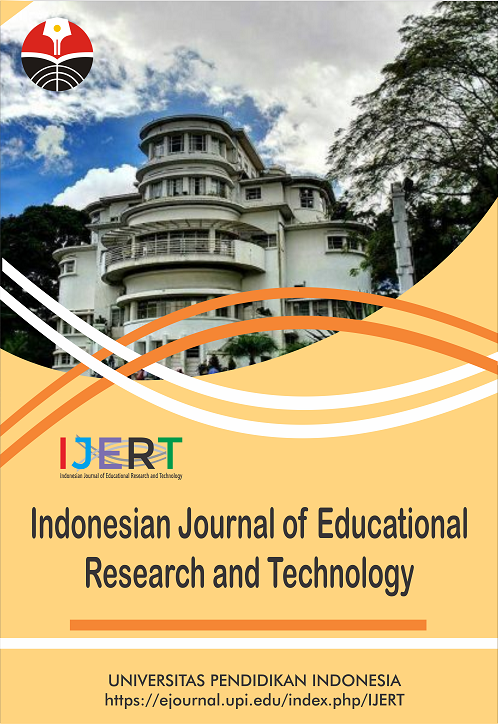Authentic Assessment Tools: Implication to Enhancement of Learning among Undergraduate Science Student-Teachers
Abstract
Keywords
Full Text:
PDFReferences
Abrahams, I., Reiss, M. J., and Sharpe, R. M. (2013). The assessment of practical work in school science. Studies in Science Education, 49(2), 209–251.
Amankwah, F., Oti-Agyen, P., and Sam, F. K. (2017). Perception of pre-service teachers towards the teaching practice programme in college of technology education, University of Education, Winneba. Journal of Education and Practice, 8(4), 13–20.
Ashford-Rowe, K., Herrington, J., and Brown, C. (2014). Establishing the critical elements that determine authentic assessment. Assessment and Evaluation in Higher Education, 39(2), 205–222.
Broadbent, J., Panadero, E., and Bouda, D. (2018). Implementing summative assessment with a formative flavour: A case study in a large class. Assessment and Evaluation in Higher Education, 43(2), 307–322.
Darling-Hammond, L., and Snyder, J. (2000). Authentic assessment of teaching in context. Teaching and Teacher Education, 16(5), 523–545.
Flores, I. M. (2015). Preservice teachers as investigative science mentors: Advancing self-efficacy through school-based professional development. Journal of Instructional Pedagogies, 17, 1-27.
Gallardo, K. (2020). Competency-based assessment and the use of performance-based evaluation rubrics in higher education: Challenges towards the next decade. Problems of Education in the 21st Century, 78(1), 61–79.
Gulikers, J., Bostiaens, T. J., and Kirschner, P. A. (2004). A five-dimensional framework for authentic assessment. Educational Technology Research and Development, 52(3), 67–86.
Herrington, J., Reeves, T. C., and Oliver, R. (2006). Authentic tasks online: A synergy among learner, task, and technology. Distance Education, 27(2), 233–247.
Hilden, R., Oscarson, A. D., Yildirim, A., and Fröjdendahl, B. (2022). Swedish and Finnish pre-service teachers’ perceptions of summative assessment practices. Languages, 7(1), 10.
Houston, D., and Thompson, J. N. (2017). Blending formative and summative assessment in a capstone subject: ‘it’s not your tools, it’s how you use them.’ Journal of University Teaching and Learning Practice, 14(3), 1-13.
Ishaq, K., Rana, A. M. K., and Zin, N. A. M. (2020). Exploring summative assessment and effects: Primary to higher education. Bulletin of Education and Research, 42(3), 23–50.
James, L. T., and Casidy, R. (2018). Authentic assessment in business education: its effects on student satisfaction and promoting behaviour. Studies in Higher Education, 43(3), 401–415.
Jarrah, A. M. (2020). The challenges faced by pre-service mathematics teachers during their teaching practice in the UAE: Implications for teacher education programs. International Journal of Learning, Teaching and Educational Research, 19(7), 23–34.
Klenowski, V., Askew, S., and Carnell, E. (2006). Portfolios for learning, assessment and professional development in higher education. Assessment and Evaluation in Higher Education, 31(3), 267–286.
Makafane, T. D. (2020). Student Teachers Challenges in the Preparation and Implementation of Microteaching: The case of the National University of Lesotho. International Journal of Academic Research in Progressive Education and Development, 9(2), 144-157.
Mogali, S. R., Rotgans, J. I., Rosby, L., Ferenczi, M. A., and Low Beer, N. (2020). Summative and formative style anatomy practical examinations: Do they have impact on students’ performance and drive for learning? Anatomical Sciences Education, 13(5), 581–590.
Nguyen Thi Thu, T., and Vu Dinh, P. (2021). Characteristics of authentic assessment tasks in teaching maths oriented to competency development for primary students. Journal of Science Educational Science, 66(3), 220–228.
Oladele, I. O. (2011). Knowledge and utilization of authentic assessment techniques by lecturers in Botswana college of agriculture. North American Colleges and Teachers of Agriculture (NACTA), 55(1), 63–67.
Orland-Barak, L., and Maskit, D. (2017). Portfolio as document experience. Methodologies of Mediation in Professional Learning, 14, 75–90.
Quansah, F., Ankoma-sey, V. R., and Asamoah, D. (2019). The gap between the academia and industry: Perspectives of university graduates in Ghana. International Journal of Education and Research, 7(3), 63–72.
Rawlusyk, P. E. (2018). Assessment in higher education and student learning. Journal of Instructional Pedagogies, 21, 1–34.
Ridwan, Wahyuningsih, S., and Winarno, W. (2021). An analysis of authentic assessment in English textbook “stop bullying now” used for the eleventh-grade students of senior high school. Jet Adi Buana, 6(02), 191–207.
Schultz, M., Young, K., K. Gunning, T., and Harvey, M. L. (2022). Defining and measuring authentic assessment: a case study in the context of tertiary science. Assessment and Evaluation in Higher Education, 47(1), 77–94.
Schwichow, M., Zimmerman, C., Croker, S., and Härtig, H. (2016). What students learn from hands-on activities. Journal of Research in Science Teaching, 53(7), 980–1002.
Tanner, D. E. (2001). Authentic assessment: A solution, or part of the problem? The High School Journal, 85(1), 24–29.
Villarroel, V., Bloxham, S., Bruna, D., Bruna, C., and Herrera-Seda, C. (2018). Authentic assessment: creating a blueprint for course design. Assessment and Evaluation in Higher Education, 43(5), 840–854.
Yu, S. H. (2019). Using Authentic Assessment in Information Literacy Programs: Tools, Techniques, and Strategies. Journal of the Canadian Health Libraries Association/Journal de l'Association des bibliothèques de la santé du Canada, 40(3), 137-139.
Yüksel, H. S., and Gündüz, N. (2017). Formative and summative assessment in higher education: Opinions and practices of instructors. Tojet - The Turkish Online Journal of Educational Technology, 3(8), 336–356.
DOI: https://doi.org/10.17509/ijert.v4i2.63332
Refbacks
- There are currently no refbacks.
Copyright (c) 2023 Universitas Pendidikan Indonesia (UPI)

This work is licensed under a Creative Commons Attribution-ShareAlike 4.0 International License.







.png)




